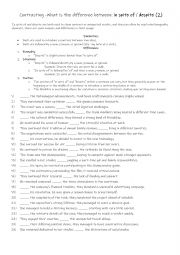
|
Contrasting - What is the difference between: in spite of / despite
In spite of and despite are both used to show contrast or unexpected results, and they can often be used interchangeably. However, there are some nuances and differences in their usage.Students learn about: formality, structure and position. Students read the sentences and complete the gap-fill with the most suitable word. This worksheet is only su...
Level: advanced
Age: 12-100
Type:
Downloads: 113
|
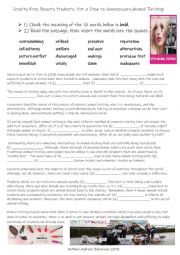
|
Cruelty-Free Beauty Products. Put a Stop to Unnecessary Animal Testing
Reading passage with a gap fill exercise about being ethically aware that many beauty products are still being tested on animals. This sheet is suitable for higher level B1 to B2 students of all ages. An answer sheet is included. For higher level students they could be put in groups to give / present their opinions in a presentation / discussion.
Level: intermediate
Age: 14-100
Type: worksheet
Downloads: 2191
|
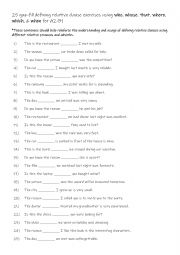
|
Defining relative clauses
25 gap-fill defining relative clause exercises using who, whose, that, where, which, & when for A2-B1
*These sentences should help reinforce the understanding and usage of defining relative clauses using different relative pronouns and adverbs.Answers on page 2.
Level: elementary
Age: 10-100
Type:
Downloads: 104
|
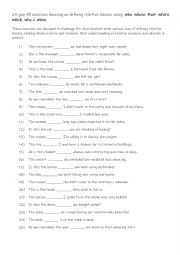
|
Defining relative clauses
25 gap-fill exercises focusing on defining relative clauses using: who, whose, that, where, which, why & when.
These exercises are designed to challenge B1 level learners with various uses of defining relative clauses, helping them practice and reinforce their understanding of relative pronouns and adverbs in context.Answers on page 2.
Level: intermediate
Age: 10-100
Type: worksheet
Downloads: 110
|
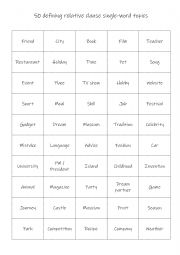
|
Defining relative clauses
50 defining relative clause single-word topics. Students pick a topic and define it.Topics include various: people, places , things and time etc. Or this worksheet can be used as a Tic-tac-toe / noughts and crosses speaking reinforcement activity for younger learners. It is suitable for B1+-C1 students.
Level: intermediate
Age: 12-100
Type: worksheet
Downloads: 114
|
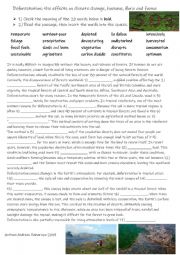
|
Deforestation. The effects on climate change, humans, flora and fauna.
710-Word reading article with a 20-word gap fill exercise about deforestation. It takes an in-depth look at the effects on climate change, humans, flora and fauna.This sheet is suitable for higher level B1-B2 students of all ages. An answer sheet is included. For higher level students they could be put in groups to give / present their opinions in ...
Level: intermediate
Age: 12-100
Type:
Downloads: 1955
|
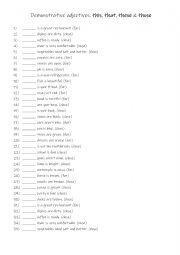
|
Demonstrative adjectives: this, that, these & those practise
Students read the sentence, then complete the gap-fill with the correct demonstrative using the given clues at the end of each sentence (near) or (far). Answers on page 2
Level: elementary
Age: 8-100
Type:
Downloads: 119
|
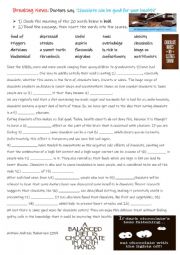
|
Doctors say, �Chocolate can be good for your health!�
360-Word reading article with a 20-word gap fill exercise about the health benefits of chocolate. It takes an deeper look at some of the positive medical effects of eating chocolate - in moderation though.This sheet is suitable for higher level A2 to B1 students of all ages. An answer sheet is included. For higher level students they could be put i...
Level: elementary
Age: 14-100
Type: worksheet
Downloads: 2069
|

|
During or while Practise 1
Using the the given grammar rules and usage on the page, students complete the sentences and questions with the correct preposition or conjunction. This worksheet is mainly for B1 level students although it could be used with strong A2+ students. There are 7 questions and sentences for both while and during. Answers are on page 2.
Level: intermediate
Age: 10-100
Type:
Downloads: 115
|
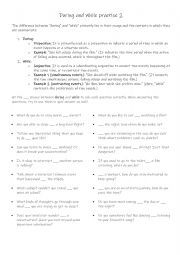
|
During or while Practise 2
Using the the given grammar rules and usage on the page, students complete the questions with the correct preposition or conjunction. This worksheet is mainly for B1 level students although it could be used with strong A2+ students. Once the worksheet has been checked,students in pairs or small groups can ask each other the questions for speaking p...
Level: intermediate
Age: 10-100
Type:
Downloads: 103
|












